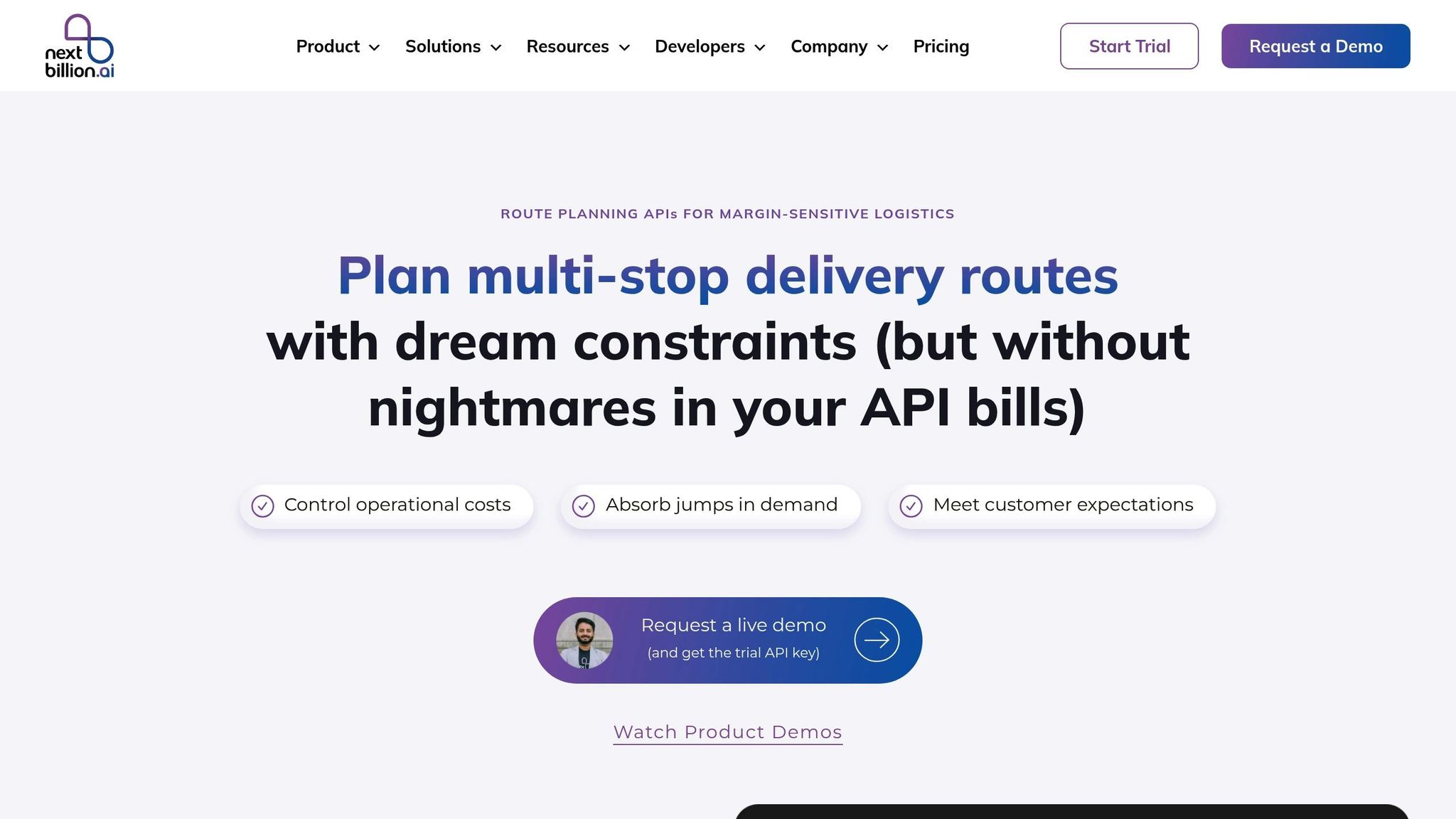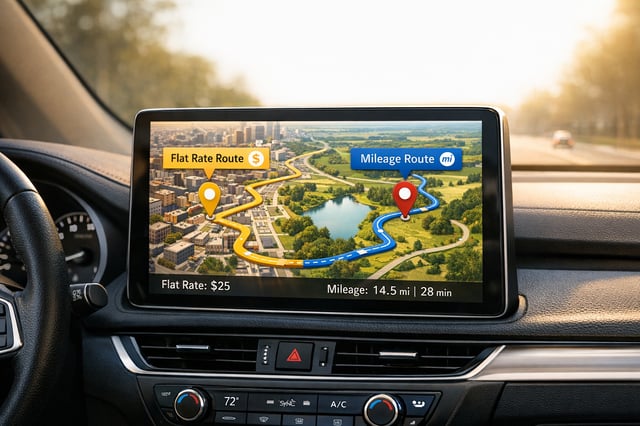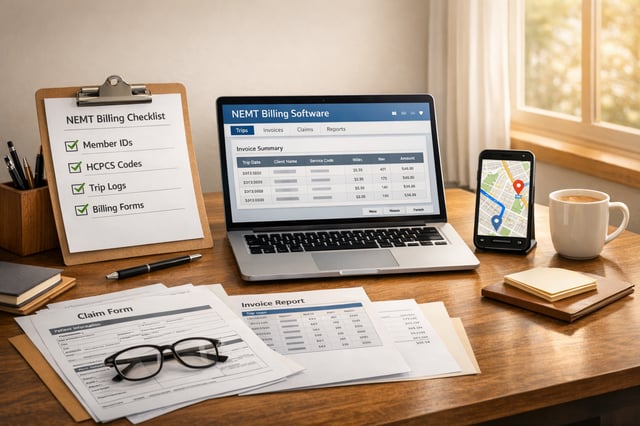

NEMT Entrepreneur provides expert insights, strategies, and resources to help non-emergency medical transportation professionals grow their businesses. Get industry-leading advice to succeed in NEMT.
Featured articles
Poor communication between drivers and dispatchers in Non-Emergency Medical Transportation (NEMT) leads to missed appointments, patient dissatisfaction, and operational inefficiencies. This article explores the core issues both roles face and how these gaps can be addressed with better tools and training.
Key Takeaways:
- Drivers' Challenges: Managing real-time issues (traffic, delays), outdated tech, and safety risks while communicating on the road.
- Dispatchers' Challenges: Handling excessive information, delayed driver updates, and making quick decisions under pressure.
- The Impact: 3.6 million Americans miss medical care annually due to transportation issues, and 80% of companies using centralized systems report fewer errors.
- Solutions: Use real-time GPS tracking, two-way messaging, and role-specific training to improve communication and efficiency.
Quick Fix: Equipping drivers with mobile-friendly tools and dispatchers with integrated systems can improve efficiency by 15% and reduce miscommunication by 80%.
Non-Emergency Medical Transportation (NEMT) Dispatch Planning Demo | NextBillion.ai

Communication Problems Drivers Face
In NEMT (Non-Emergency Medical Transportation) operations, smooth communication is a cornerstone of success. However, drivers often encounter obstacles that make this a tough task. Unlike office workers who operate from a stationary location, drivers must juggle real-time communication demands while focusing on patient safety and navigating through chaotic streets.
Handling Real-Time Problems
A traffic jam on I‑95 or a patient requiring extra assistance can cause a 15-minute delay to spiral into a scheduling nightmare. These small disruptions can ripple through the day, creating route and timing challenges. Drivers also face sensitive situations, like delays with elderly patients or malfunctioning equipment, where they need to communicate precise details to dispatch. On top of that, unexpected changes - construction zones, road closures, or even misleading GPS directions - require immediate updates. Balancing the urgency of these updates with the need to stay safe on the road adds another layer of complexity.
Working with Basic Technology
Many NEMT operations still rely on outdated tools that aren’t built for the fast-paced, mobile demands of medical transport. Drivers often use basic cell phones, older GPS systems, and text-based communication platforms that struggle to keep up with their needs.
In rural areas, spotty cell phone coverage can result in 20–30 minutes of total communication blackout. Outdated GPS devices frequently direct drivers to main entrances instead of the specific drop-off points required for medical transport. For drivers unfamiliar with advanced tech, typing detailed updates on small screens can be frustrating, leading to unclear or incomplete messages. Language barriers add another wrinkle - drivers who speak English as a second language often prefer verbal communication, but many dispatch systems rely heavily on text messaging.
Staying Safe While Communicating
The constant need to stay in touch with dispatch can pose serious safety risks for drivers. Federal laws prohibit commercial drivers from texting while driving, but the demand for real-time updates can put drivers in tough situations.
Distracted driving data paints a stark picture: a 2009 study revealed that 71% of large-truck crashes occurred when the driver’s attention was diverted from the road. Texting while driving increases the chance of a safety-critical event by 23 times; using a dispatch device raises the risk 9 times; and dialing a handheld phone triples the likelihood of an accident.
To avoid these risks, drivers often pull over to communicate, but in crowded urban areas, finding a safe spot to park can delay patient transport. Even hands-free systems, while helpful, can still cause distractions - especially if the vehicle lacks advanced Bluetooth connectivity. In emergencies where quick communication with dispatch and emergency services is vital, drivers face an almost impossible balancing act. Research shows that nearly 80% of crashes involve some form of driver inattention in the three seconds leading up to the incident. Even a momentary lapse can have serious consequences.
These hurdles for drivers highlight the unique challenges they face, setting the stage for a closer look at the issues encountered by dispatchers.
Communication Problems Dispatchers Face
While drivers deal with challenges on the road, dispatchers face their own set of hurdles behind the scenes. From managing overwhelming amounts of information to handling delayed updates, their role is anything but simple.
Handling Too Much Information
Dispatchers are often bombarded with an incredible volume of communications every day. For example, in a 60-truck fleet, a dispatcher might handle between 120 and 180 communications per hour. This constant flow of updates, requests, and reports creates a high-pressure environment where critical details can easily get lost.
The situation becomes even more difficult when dispatchers rely on outdated tools like paper logs or manual communication methods. Frequent phone calls and interruptions disrupt their workflow. On top of that, many dispatchers lack firsthand field experience, which can lead to misunderstandings. For instance, when a driver reports a "minor delay", the dispatcher might not fully grasp the severity of the situation. This disconnect can lead to miscommunication, especially during high-stress periods when tasks need to be prioritized quickly.
Waiting for Driver Updates
Another major challenge dispatchers face is dealing with delayed updates from drivers. When drivers fail to check in on time, dispatchers are often left guessing. For example, if a driver expected at 2:00 PM hasn’t reported by 2:30 PM, the dispatcher has to determine whether the delay is due to traffic, a mechanical issue, or an emergency. Without real-time updates, dispatchers are forced to make decisions based on incomplete information, which can disrupt schedules and lead to inaccurate communication with patients and healthcare facilities.
Poor communication between dispatchers and drivers also contributes to high turnover rates. Studies show that 35% of drivers leave a company within the first three months, and 70% quit within the first year. This highlights how critical clear and timely communication is for maintaining a stable workforce.
Fixing Problems Fast
When issues arise, dispatchers are expected to act quickly to keep operations running smoothly. A vehicle breakdown at 3:00 PM, for instance, can lead to a chain reaction of missed appointments unless the dispatcher immediately reassigns routes, notifies patients, and arranges alternative transportation. Relying on outdated systems can slow down this process, making it harder to prevent disruptions.
The financial impact of communication breakdowns is significant. A 2022 study by Interos revealed that companies faced an average of three major supply chain disruptions over the year, costing them $182 million in lost revenue. While NEMT operations might not see losses on that scale, similar communication failures can still hit their bottom line hard.
Dispatchers also have to manage relationships with diverse stakeholders, including drivers, patients, healthcare providers, and insurance companies. What seems like a small delay to one person might be a critical issue for a patient waiting for transportation. As the day unfolds and new issues arise, dispatchers must continuously reassess priorities. A schedule that looks manageable at 8:00 AM can spiral into chaos by noon if unexpected problems crop up.
COO Nazar Kvartalnyi of Inoxoft points out how technology can help:
"You see, sometimes even a simple solution like a delivery logistics driver app can work wonders with your business challenges. That's the real magic of technology. But here's the key thing – it needs to be tailored specifically to your processes and unique challenges. Sure, marketplaces are full of ready-made apps, and that's great. But let's face reality - you won't be able to fully control such a solution or connect it with other systems. And for logistics, you'll agree, that's critical."
The constant demand for quick problem-solving can take a toll on even the most experienced dispatchers. Without the right tools and systems in place, the pressure of making rapid decisions can become overwhelming. In the world of NEMT, swift action isn’t just helpful - it’s essential for keeping patient appointments on track.
sbb-itb-cef70f4
How to Fix Communication Problems: Methods and Tools
Improving communication between drivers and dispatchers requires a combination of targeted training, modern technology, and ongoing skill development. Companies that focus on these areas often experience smoother operations and higher employee satisfaction. Below are some effective strategies and tools to address these challenges.
Building Understanding Through Training
Training programs that use role-playing and scenario-based exercises can help bridge gaps in understanding. For example, pairing new team members with seasoned staff in a buddy system fosters collaboration and problem-solving. Regularly reviewing real-life scenarios and hosting knowledge-sharing sessions encourage continuous learning and build a culture where communication thrives.
Using Digital Communication Tools
Cutting-edge NEMT software plays a key role in improving communication. Features like real-time GPS tracking, push-to-talk driver apps, and two-way messaging with event notifications ensure faster and more reliable exchanges. Customized alerts for events such as license renewals or trip arrivals help teams stay on top of critical tasks.
These tools not only make operations more efficient but also prove their value in real-world applications. For instance, in July 2025, Bambi Health partnered with Call the Car, a NEMT broker, to integrate trip assignments directly into dispatching software. This reduced manual work, minimized errors, and enabled automatic post-trip data updates.
"This connection with Bambi helps our network of providers operate more effectively and efficiently, ultimately benefiting the people we all serve by ensuring safe and timely access to critical medical treatments."
– Michael Fell, C.O.O. of Call the Car
Additional features, such as integrated VoIP and real-time driver assignment tools, allow teams to make quick adjustments when needed, further enhancing communication.
Training in Active Listening and Concise Messaging
Active listening and clear communication are essential skills for both drivers and dispatchers. Training programs focusing on these areas, along with tone awareness and cultural competence, can significantly reduce misunderstandings and improve response times. Encouraging team members to report issues as they arise and provide regular updates on task progress ensures smoother workflows.
A case study from Diag, a Vietnamese medical laboratory, highlights the impact of effective communication tools. By using Cartrack Delivery for smart dispatching, Diag improved task allocation and communication, scaling their business by over 1,200% while cutting logistics administrative costs by half.
Practical training that aligns with day-to-day operations strengthens working relationships and leads to more efficient, cohesive teams.
Side-by-Side Comparison: Drivers vs. Dispatchers
Let’s break down the communication challenges faced by drivers and dispatchers into a clear, side-by-side comparison. Each role comes with its own unique hurdles, shaped by their responsibilities and work environments.
Drivers juggle safety and connectivity while on the move. They deal with real-time issues like breakdowns, traffic delays, or passenger needs - all while navigating busy streets or assisting riders. Their communication must be quick, clear, and often happens under high-pressure conditions.
On the other hand, dispatchers work from a central location, managing multiple drivers and processing a constant flow of information - from GPS updates to driver reports. Their challenge is to prioritize urgent communications while keeping an eye on the entire fleet’s operations.
The gap widens when it comes to technology. Drivers typically use mobile devices and simple apps, while dispatchers rely on office-based systems with advanced integrations. This mismatch can cause miscommunication, especially when information doesn’t seamlessly translate between tools.
Role Comparison Table
Here’s a detailed breakdown of the challenges and needs for each role:
| Aspect | Drivers | Dispatchers |
|---|---|---|
| Primary Communication Challenges | Managing real-time issues, using basic tech, and staying safe while communicating | Handling information overload, waiting for driver updates, and quick problem-solving |
| Communication Environment | On the move - often driving or assisting passengers | Stationary office with access to multiple communication channels |
| Technology Requirements | Mobile apps, GPS, and simple interfaces | Advanced systems, multiple screens, and integrated data tools |
| Information Flow | Reporting issues, requesting help, and providing updates | Coordinating routes, sharing traffic updates, and managing schedules |
| Time Sensitivity | Immediate responses critical for safety and passenger care | Continuous monitoring with fast decision-making |
| Best Communication Tools | Mobile dispatching apps, GPS tracking, and telematics | Cloud-based hubs, AI tools, and real-time tracking systems |
| Training Focus | Mobile device usage, safety protocols, and concise reporting | Multi-tasking, prioritizing information, and mastering system integrations |
Studies show that logistics companies using centralized communication tools see an 80% reduction in errors and miscommunication. Additionally, when drivers are equipped with mobile-friendly solutions and dispatchers have access to comprehensive data systems, operational efficiency improves by 15%.
Bridging this gap means equipping drivers with simple, mobile solutions and providing dispatchers with robust, integrated systems. The right tools ensure both roles can perform effectively without compromising their core responsibilities.
"Effective communication between truck drivers and dispatchers is a cornerstone of success in the trucking industry. It can lead to immediate improvements in delivery times, enhanced driver safety, and increased employee satisfaction."
These insights set the stage for selecting the right communication tools and training strategies, which will be explored in the next sections.
Conclusion: Better Communication in NEMT
Strong communication between drivers and dispatchers is at the heart of safe and efficient Non-Emergency Medical Transportation (NEMT). When these two roles collaborate effectively, operations run smoother, passengers feel more secure, and overall service quality improves. This teamwork becomes even more impactful when supported by advanced tools and purposeful training.
Achieving this requires a dual focus: leveraging modern technology and building mutual understanding through training. Tools like mobile apps, GPS tracking, and integrated platforms enable real-time updates, trip monitoring, schedule adjustments, and direct communication. These technologies not only improve efficiency - boosting operations by 15% - but also enhance patient safety by providing immediate updates about medical needs and optimizing routes .
Delays are a common challenge in NEMT, with nearly 30% of patients missing appointments due to service disruptions. However, when drivers can quickly report traffic problems and dispatchers can reroute vehicles in real time, many delays can be avoided, turning potential setbacks into manageable solutions.
While technology addresses logistical challenges, training fosters stronger collaboration. Empathy and understanding between drivers and dispatchers are crucial. Drivers benefit from recognizing the high-pressure environment dispatchers navigate, while dispatchers gain insight into the safety concerns and on-the-road challenges drivers face. This shared perspective strengthens communication and reinforces a shared commitment to passenger care.
At the end of the day, drivers and dispatchers are partners working toward a common goal: ensuring passengers reach their medical appointments safely and on time. With open communication, supported by the right tools and training, NEMT services can move from simply reacting to problems to proactively delivering better care.
FAQs
What communication issues can arise between drivers and dispatchers in NEMT due to outdated technology?
Outdated technology often creates serious communication hurdles in Non-Emergency Medical Transportation (NEMT). For instance, it can cause delays or errors in ride coordination, leaving dispatchers unable to relay timely updates to drivers. This can lead to missed appointments, extended wait times for passengers, and a noticeable drop in operational efficiency.
On top of that, outdated communication tools can increase the likelihood of mistakes, such as incorrect routing or scheduling conflicts. These errors not only disrupt service but can also pose safety risks. Adopting modern, dependable technology is key to improving communication between dispatchers and drivers while ensuring smoother, more efficient operations.
What are the best ways to improve communication and collaboration between drivers and dispatchers?
Improving communication between drivers and dispatchers starts with practical, hands-on training. By incorporating role-playing exercises, both drivers and dispatchers can step into each other's shoes, gaining a better understanding of the challenges each side faces. This approach builds empathy and encourages stronger teamwork.
Leveraging real-time tools like GPS tracking and two-way messaging systems keeps everyone on the same page. These tools allow both parties to stay updated and react promptly to any changes on the road. Training on communication protocols and using specialized software can also help streamline operations and reduce the chances of miscommunication.
For teams dealing with language differences, providing language support or courses can make a big difference. This ensures that everyone can communicate clearly, helping the entire team work more effectively together.
How does clear communication between drivers and dispatchers improve patient safety and service quality in NEMT operations?
Clear communication between drivers and dispatchers plays a key role in maintaining patient safety and providing reliable service in non-emergency medical transportation (NEMT). When information is shared accurately and promptly, it helps avoid delays, reduces mistakes, and ensures patients are picked up and dropped off on time.
Strong communication also makes it easier to address unexpected challenges, like traffic jams or last-minute schedule adjustments. This kind of teamwork boosts reliability, fosters trust with patients, and ensures their needs are handled with care and professionalism.


